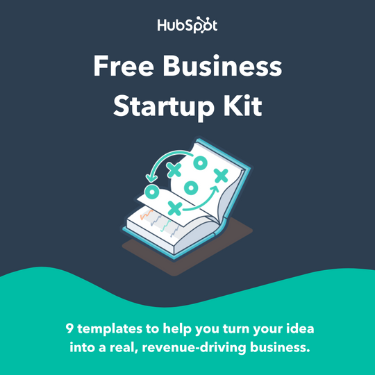The dominant narrative of business growth focuses on unicorn startups helmed by eccentric but brilliant Silicon Valley technocrats that venture capital firms pour money into. The true reality is that most startups and small businesses rely on personal savings for initial funds — and a third start with less than $5k.
Download Now: Startup Fundraising Kit [Free Guide]
Because of this, knowing how to find investors is a critical part of entrepreneurship. In this piece, I’ll dive into the types of investors you can have for your business, and anecdotes and advice from experienced entrepreneurs on how to find investors for your business.
Table of Contents
- Know Why You Want Funding In The First Place
- The Different Types of Investors
- How to Find Investors For Your Business
- How to Choose an Investor

Free Business Startup Kit
9 templates to help you brainstorm a business name, develop your business plan, and pitch your idea to investors.
- Business Name Brainstorming Workbook
- Business Plan Template
- Business Startup Cost Calculator
- And more!
Download Free
All fields are required.

Know Why You Want Funding In The First Place
“I’m the female founder of a breastfeeding technology company based in the state of Maine. People aren’t pounding down my door offering me funding,” laughs Amy VanHaren, CEO and founder of Pumpspotting, a startup focused on removing barriers around breastfeeding and baby feeding in the workplace. “I started self-funded because I wanted to make sure there was a product-market fit and that the idea was resonating. It was risky, but seeing that success [with my own funding] felt so good.”
VanHaren began her business in 2016 with savings and tried alternative funding methods like starting a Kickstarter campaign, applying for grants and pitch competitions, and raising a friends and family round. She eventually closed her 1st pre-seed round of VC and angel funding for $1.5m in July 2021.
Startups can raise millions of dollars and still crash and burn — often because they take funding before they’re ready to execute their concept, or because they feel pressured to raise venture capital as a way to validate their ideas. For instance, 60% of companies that raise a pre-seed series fail to proceed to the next round, according to TechCrunch.
Rather than pursuing funding right out of the gate, VanHaren recommends thinking methodically about what the money will achieve, and why you need it. “Funding is most effective in helping you advance to the next milestone and should align with the growth stage that you’re at,” she says. “We didn’t take funding until we were really on a path of scale and growth, because we saw we were in a position with our business model that funding would unlock real impact on our community.”
Anna Ford, co-founder and CEO of online book club community Bookclubs, had a similar funding journey of using Kickstarter and friends and family, then landing a $1.5m pre-seed round in 2020. “Once I realized how large our weekly and monthly organic growth rate was, I knew that wow, if I had some resources to really develop the product, there’s a big opportunity here,” she says. “Don’t fundraise just for the glory or validation in the funding. Make sure that you’re using capital to answer a question or add more value, letting money follow the story instead of the other way around.”
Before you think about taking money from any source, make sure you’ve evaluated your business model and your own goals. Ask yourself:
- Is my product-market fit solid?
- What is our current operating budget?
- What is the next growth milestone we want to hit, and what would it take to get there?
- What will this funding achieve, specifically? (A new hire or team, product development resources, marketing and advertising, and so on)
- How much funding do I need to achieve that goal?
- Am I ready for external opinions to shape my business?
The Different Types of Investors for Startups
Before you start looking for investors, I recommend considering the different types of funding you can use for your business.
There’s no one “right” way to choose a type of funding — you may end up using all of these at some point in the lifetime of your business:
- Bootstrapping: Self-funding your business through existing resources you already have, such as personal savings, your home or apartment, and your personal computer. This allows you to maintain complete control over the business and run a lean organization — but it can limit your growth or cause you to take shortcuts or hacks that make it difficult to scale later. This is also the most personally risky option, as it all comes down to your own cash.
- Crowdfunding: Using a platform like Indiegogo, Crowdfunder, or Kickstarter to tap into a larger community of potential customers, with easier entry points for them to invest in your business (as low as $10 or $20, as opposed to millions). This gives you access to a new customer base and funding, but most platforms require you to raise the full goal amount to receive the money. Plus, it often means you’re on the hook for a gift or product in exchange for the investment.
- Small business grants: As a small business, you’re eligible to apply for a range of federal, state, and nonprofit grants to finance your venture. While every grant has a different application process, they often come with some level of support, such as a residency, team of advisers, or access to spaces and equipment you wouldn’t otherwise be able to obtain. Unlike loans, these don’t need to be repaid.
- Small business loans: You can also apply for a loan through your local banking institution. The US Small Business Administration, a federal agency dedicated to helping small businesses and startups, offers a variety of financial tools such as 504 loans and 7(a) loans, as well as short-term programs like covid relief. This process helps you get money when you need it, but unlike other types of funding, you’re expected to pay back your loan, potentially with interest.
- Startup accelerators and pitch contests: Participating in a small business or industry accelerator program can provide access to funding, pitch contests, and a deep network of experts looking to give back to other entrepreneurs. While applying and participating in these programs can take a lot of time and energy, it’s a great way to build relationships, crystallize your strategy and product, and plug in to local resources and funding.
- Friends and family: Similar to bootstrapping, a friends and family round is usually a small fundraising series built out of the founder’s personal network. This type of “pre-seed” round is designed to help get your business off the ground. Most of the time, this does not require you to offer equity or other stake in the company.
- Angel investors: Angel investors are professional, accredited investors that are not necessarily associated with a larger company or fund. They invest their own money into your venture, and are often willing to take bigger risks on businesses they’re passionate about. Adding angel investors may require you to cede some element of control, such as giving them a role as an adviser or board member, or providing equity.
- Venture capital: The most traditional source of startup funding is through venture capital firms, which have large pools of investor money and can provide significantly more cash than the other types on this list. These firms expect an equity stake in your company, plus influence on your business decisions. They may ask for participation on the board or executive leadership.

Free Business Startup Kit
9 templates to help you brainstorm a business name, develop your business plan, and pitch your idea to investors.
- Business Name Brainstorming Workbook
- Business Plan Template
- Business Startup Cost Calculator
- And more!
Download Free
All fields are required.

How to Find Investors for Your Business
Finding investors takes a lot of work, especially for underrepresented groups like women and BIPOC founders.
While there are many different types of funding, entrepreneurs sometimes have to connect with multiple investors before finding the right one(s).
To help you get the ball rolling on investor connections, I asked entrepreneurs how they found investors for their businesses. Here’s their advice.
1. Use LinkedIn to identify investors with shared passions
“It’s very much about relationships,” says VanHaren. “For us, we’re a femtech company focusing on the future of work, so for me to find angel investors or VCs, I’m looking on LinkedIn or Googling people and firms that are passionate champions of the type of work we’re doing in the space. You need to put yourself out there.”
To find relevant connections, I recommend LinkedIn’s advanced filtering options. You can set your country and use the company filter to find specific firms. Most angel investors or VC firms have "capital," "venture," or "investor" in their names, so putting these terms in the company search box will give you a broad list to start from.
Also make sure that your own LinkedIn profile is up to date, with a catchy headline, exciting summary and relevant content related to your company, so investors who do connect will take your asks more seriously.
2. Expand your circle by asking for introductions.
A great way to start finding investors is by expanding your network.
“As we started to build relationships with angels and venture funds, we realized that everybody knows everybody in those circles, so you need to ask for those introductions,” says VanHaren. “It can also be geographically or through programs and groups, like female founder groups or boot camps, so you can be in a place where people are having those investor conversations.”

If you’re using this method, my top tip is to do your homework before reaching out. Asking connections for a general introduction (e.g., do you know any investors who would be interested in my business?) isn’t as impactful as asking for connections to people you know are involved in similar ventures. For example, being specific about requesting an introduction to VCs with a track record of investing in your industry is likely more helpful.
3. Meet investors where they are.
If you’re just starting out, look for investors where they might already be—industry trade shows and conventions, business events, and sometimes even co-working spaces.
Andrew Lee Jenkins, owner of Andrew Lee Jenkins, told me he found investors by attending industry events and pitch competitions. He says. “In my opinion, this approach worked well because it created direct access to people interested in investing while also showcasing my business in a public setting. It was a way to build credibility and momentum at the same time.”
Inge Von Aulock, Founder & COO of Penfriend, told me she did the same thing: “When I sought investors for my business, I focused on building relationships through industry networking events and targeted pitch opportunities. I chose this route because it allowed me to connect with people who not only had the capital but also shared a genuine interest in the industry my business operated in.”

4. Get involved in your community.
Remember to look around you. Your community likely has a network of individuals who share your interests and can introduce you to investors in your field or are one of those people themselves.
Local business schools have alumni networks, chambers of commerce, chapters of associations like the National Federation of Independent Business, and SBA community groups, which are good ways to connect with other entrepreneurs and be introduced to potential investors.
The entrepreneurs I spoke to agreed with this strategy, especially Jayen Ashar, CTO of Scaleup Consulting. He says, “Finding investors for my business was similar to how I found a cofounder—by immersing myself in communities passionate about the same problem. In my case, the focus was on housing affordability.”
Doing this worked for him: “[At a local affordable housing event], I met a small group of socially-conscious investors. They were looking to back innovative solutions in the housing sector. The alignment in values made it easier to build trust and secure funding. The key takeaway is to engage deeply with communities that care about your problem—this increases the chances of finding investors who are not just financiers, but true partners in your mission.”

5. Seek support from family and friends
Those closest to you — your friends and family — can also be important allies. They may become your startup's first investors or be willing to vouch for you to investors they know.
“I turned to my closest circle for funding support when I was starting my small wallet brand. My family and friends were my biggest supporters from day one. My family already knew about my business idea for a while, and they believed in my vision, so they were more than happy to be my first investors. Friends who were my first customers and became fans of my product also expressed their interest in investing and helping me scale after my first year,” says Joel Popoff, CEO of Axwell Wallet.
I have to mention that it’s important to navigate this carefully to avoid damaging your relationships. Be clear about what you’re after, provide an honest and comprehensive business plan to any family investors, and get all the agreements down on paper.
6. Explore crowdfunding and brand building opportunities
Crowdfunding has become an increasingly popular tool for raising initial funding for innovative projects. Moreover, successful crowdfunding campaigns create buzz and coverage for your company that may lead to further investment. Some sites, like Kickstarter, even feature popular campaigns on their home page, putting you front and center for interested investors.
A unique aspect of crowdfunding is that it allows you to tell your story, create a following, and get the attention of influential people who are watching the space.
Paul Jameson, Founder of Aura Funerals, tells me that he picked crowdfunding because it aligned with the company he wanted to build and allowed him to connect with people who shared his vision. He says that looking back, early investors (from crowdfunding) were “The foundation of our success. Seeing their share value grow tenfold since then is one of the things I'm most proud of. It feels like a win for Aura and everyone who believes in us. Crowdfunding worked for us because it wasn't just transactional but personal.”
7. Consider incubator and accelerator programs.
Startup incubators and accelerators can provide access to mentorship networks and willing investors.
“At the beginning of my entrepreneurship journey, I sought support from startup accelerators and incubators…the main reason behind that investor-finding method was easy access to a pool of investors who would otherwise be out of reach,” shares Nina Paczka, Career Expert & Community Manager at MyPerfectResume. “These investors are inherently interested in supporting your business, reducing the likelihood of disappointment and significantly shortening the time needed to secure funding.”
Paczka adds that another benefit to startup accelerators and incubators is that the programs act as personal advisors, helping you build the plans you need to run a successful business. She adds, “They [accelerator programs] work in your favor, pitching your business to venture capitalists, angel investors, and other funders. Also, many accelerators offer initial funding in exchange for equity in the company.”
How to Choose an Investor
Once you know where you’ll find your investors, the next step is matching those investors and funding types with your business's current growth cycle and not taking more than you need at a given time.
“Some investors only want to invest in a moonshot,” says Ford. “I wanted to build our business in a methodical, step-by-step way, so those investors generally aren’t a fit for me. Be OK with saying no if it’s not a fit.”
Once you’ve started those conversations, it’s important to make sure you choose investors that fit your business vision and values.
According to Ford, “You’re judging them just as much as they’re judging you in terms of what value they bring to what you’re building. As a female founder, I wanted gender equity on my cap table, and now that the team I was building was something that I could be proud of.”
It’s easy to get dazzled by the prospect of any kind of funding, but remember that many investors come with an expectation — a board seat, a decision-making role, a financial return. “I’ve had a number of moments talking with potential investors where I felt like they weren’t seeing the vision of where I wanted our business to go, or they had very strong opinions on our path, and it didn’t feel aligned,” says VanHaren. “You have to know if you take that money, they’re going to steer you in a certain place.”
Think of your investor discovery calls as discovery for both of you, not just a chance to run through your pitch deck. I recommend asking:
- What types of communications do you have with the founders you invest in, and how often?
- How do you help your founders beyond capital investments, and what does that look like?
- Which of our growth milestones are you most excited about?
- What has impressed you the most about some of the founders that you’ve worked with?
- When things get tough in the business, how do you show up?
Fundraising is one of the most challenging elements of being a founder.
Fundraising isn’t easy for any entrepreneur, regardless if they’re spinning up a pre-seed round or hitting their Series C or D. “There are times when you’ll have a lot of doubt about your path, but the thing to remember is that everyone goes through it, and it’s all part of the process,” says VanHaren.
Remember why you’re doing what you’re doing, and what that funding will unlock. “I started this business as a personal project in 2015, and didn’t receive funding until 2020,” says Ford. “But now, we’re serving 275k readers with book clubs in over 70 countries in the world. It’s been a grueling way to do it, with a lot of my own personal investment and time, but it’s because I love this company and I love this community.”

Free Business Startup Kit
9 templates to help you brainstorm a business name, develop your business plan, and pitch your idea to investors.
- Business Name Brainstorming Workbook
- Business Plan Template
- Business Startup Cost Calculator
- And more!
Download Free
All fields are required.

Entrepreneurship




![Inside Holding Companies — The Entities That Own Popular Businesses [+ Expert Tips]](https://53.fs1.hubspotusercontent-na1.net/hubfs/53/holding-companies-1-20250502-5640825.webp)
![Grants for Black women and women of color [+ 2025 deadlines]](https://53.fs1.hubspotusercontent-na1.net/hubfs/53/grants-for-black-women-1-20250328-4679344-1.webp)

![Everything You Need to Know about Partnership Businesses [+ Expert Tips]](https://53.fs1.hubspotusercontent-na1.net/hubfs/53/partnership-business-1-20250219-4868724.webp)

![Entrepreneurial Marketing: Find New Customers on a Shoestring Budget [+Expert Tips]](https://53.fs1.hubspotusercontent-na1.net/hubfs/53/entrepreneurial-marketing-1-20250220-651487.webp)
![Entrepreneurship Trends That Will Change the Business of Building Businesses in 2025 [Expert & Data-Backed Predictions]](https://53.fs1.hubspotusercontent-na1.net/hubfs/53/entrepreneurship-trends-1-20250219-7312699.webp)
